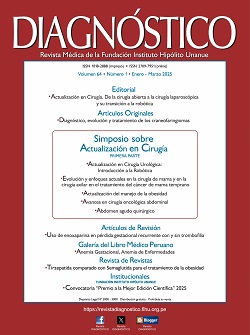Diagnosis, evolution and treatment of craneofaringiomas
DOI:
https://doi.org/10.33734/diagnostico.v64i1.569Keywords:
Hypothalamus. pituitary, craniopharyngiomasAbstract
Objective: To describe the clinical and metabolic characteristics of craniopharyngiomas. Material and methods: To descriptive, cross-sectional, retrospective study of 10 cases of sellar craniopharyngiomas of those who were attended in author´s private practice, collected from january 2 to march 31, 2023. Information is given on age, weight, height, BMI, blood pressure,
concentrations of prolactin (PRL), thyrotrophic hormone (TSH), luteotrophic hormone (LH), follicle-stimulating hormone (FSH), somatotropin (STH), thyroxine (T4), triiodo-thyronine (T3), cortisol (F), testosterone (T) in men, estradiol (E2) in women, glucose (G). Stimulatory tests with TRH, GnRH, insulin hypoglycemia, x-rays, ocular campimetry and treatment. Results: 30%
women, 28.1±19,5 years old, weight 42.9±12,0 kg, height 1.35±0,12 m, BMI 23.3±3,91 BP 108.0/73.8 mmHg, PRL 26±3 ng/ml, STH 0.47±0.53 ng/ml ml, TSH 5.3±2.4mIU/L, LH 0.92±0.67IU/L, T4 4.8±3.7 ug/dl, T3 100±10 ng/dl, F 3.5 ±3 .78ug/dl, T
1.76±1.26 ng/dL, E2 15.7±6.03 pg/ml G 79.3±6.15. TRH test: 7, 2.9, 4.2 mIU/L TSH. GnRH test: 1.09, 1.95, 3.03, 3.05, 1.17 IU/L LH. Insulin hypoglycemia: 0.43, 0.62, 0.47, 0.4, 0.43 ng/ml STH; 3.5, 4.17, 6.2, 6.43, 5.47 ug/dL cortisol. All showed an increase
in the sella turcica, several with calcifications in the cystic images. The majority had vision impairment that led to blindness. They underwent transsphenoidal hypophysectomy. Two patients developed diabetes insipidus before the quirurgic treatment. Conclusions: Craniopharyngiomas had basal hormonal concentrations in the normal range and limited responses to stimulatory tests.
Downloads
Metrics
References
.
Downloads
Published
How to Cite
Issue
Section
License
Copyright (c) 2025 Fausto Garmendia Lorena

This work is licensed under a Creative Commons Attribution 4.0 International License.


























